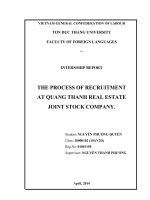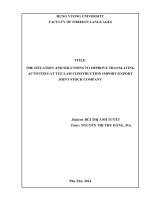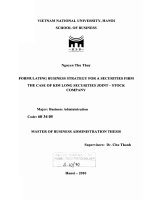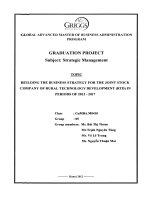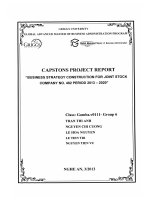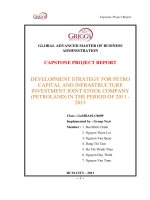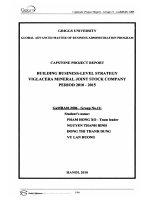The human resource development strategy at the joint stock company of autoparts and industrial equipments manufacturing
Bạn đang xem bản rút gọn của tài liệu. Xem và tải ngay bản đầy đủ của tài liệu tại đây (2.37 MB, 99 trang )
“THE HUMAN RESOURCE DEVELOPMENT STRATEGY AT THE JOINTSTOCK COMPANY OF AUTOPARTS AND INDUSTRIAL EQUIPMENTS
MANUFACTURING
INTRODUCTION
URGENCY OF THE DISSERTATION
Human, resource of all resources is the motivation for the development of human
society since its initial formation and development until now. Hence, countries and
ethnic communities around the world are all concerned about human, especially human
training and development, and consider this as the most important element to the
success in our development progress.
Practice has proven that not only resource-rich countries are able to develop
modern industry with high living standard. On the contrary, there are small countries
where natural resources or other advantages are limited, however, by using appropriate
development policies, utilizing and promoting their strengths and especially developing
the special element - human resource, they have become developed countries and
strong economies in the world, such as Japan.
In the increasing globalization trend nowadays, where the international division of
labor has been taking place strongly and dramatically, the most important advantage
that plays as the key in long term must be the high quality of human resources. Because
the lack of capital resources can be solved by mechanisms and policies, the lack of
technology and equipments can be overcome by purchasing etc., however, the lack of
high-quality human resources cannot be easily absorbed as for modern technology. We
cannot convert the capital or modern technology into this valuable asset for
development. Therefore, human resources development has a decisive role for the
future of each country, each nation.
1
Vietnam is carrying out its “industrialization and modernization” in the context of
the world economy turning into the integration and globalization stage. In order to
conduct the country’s industrialization and modernization progress successfully, the
10th Congress of Vietnam Communist Party has affirmed that “Human resource – the
fundamental element to social development, rapid and sustainable economic growth”
and “Human and human resource are the decisive factor to the development of the
country in industrialization and modernization progress”. Therefore, human resource
development is the topical issue that draws lots of special attentions from national
strategic policy planners as well as corporate managers.
The Automotive industry is an important manufacturing industry which benefits
from many favorable conditions of the Party and the Government for its development.
It plays a significant role in promoting the socio-economic development progress;
contributes to accelerate the industrialization and modernization movement of the
country.
The production and business practices of Vietnamese automotive industry in the
past few years has shown that the development of the industry was still not
commensurate with the preferential conditions that the government has given to this
sector; or in another word, has shown its failure.
There are many reasons for the past failure of the automotive industry but for some
perspective, the weak ancillary industries cannot satisfy the localisation requirements
of the automotive joint-venture manufacturers in Vietnam is considered to be an
important cause. Why many other countries such as Thailand, Malaysia and Indonesia
etc. have succeeded in this sector, especially Thailand is currently the reliable address
for placing factories of the automotive industries of Japan, Taiwan etc. This is because
the supporting manufacturing businesses of these countries are well developed and
satisfy the requirements of foreign automotive manufacturers.
2
From the lesson of ancillary manufacturing of other countries within the region, in
order to develop Vietnamese automotive industry, the development of ancillary
manufacturers is a direction of prioritizing and urgent matter as expressed through the
Decision No. 12/2011/QĐ-TTg dated Feb 2nd, 2011 by a Prime Minister regarding the
development policy for several ancillary industries.
The Joint-Stock Company of Autoparts and Industrial equipments Manufacturing
JAT is a young small-and-medium-sized enterprise but has created for itself an
appearance of a company with vision, effective investment and initial reputation to a
number of automotive assembly plants of many well-known domestic and joint-venture
companies, such as TOYOTA, HONDA, etc. However, the development of the firm is
currently not really stable and strong enough to reach its goal in Strategy 2012-2020
which is: “The manufacturing enterprise with low costs and market capability in the
leading top of Northern Area of Vietnam”. Starting from such thoughts, I have chosen
the topic “The human resource development strategy at the Joint-Stock Company of
Autoparts and Industrial equipments Manufacturing JAT in 2012-2020” to do research
for my disertation.
RESEARCH PURPOSES
Base on the theorical and practical basis to suggest solutions for human resources
development of the company.
-
Clarify the basic theories about human resource and human resources
development.
-
Analyse actual situation of the company and its human resources development;
identify the achievements, issues, weaknesses and reasons. Upon analyzing the
strengths and weaknesses, opportunities and challenges to establish forecasts of
the factors that would affect the human resources development of the company.
-
Determine perspectives, objectives and orientations so as to suggest solutions
for human resources development for the company.
3
RESEARCH SCOPE
Human resource development, factors affecting human resource development and
other elements related to human resources development of the firm in 2012-2020.
RESEARCH METHODOLOGY
To use synthetically a number of methods as following:
-
Methods of systematizing, generalizing, systematic thinking, logical thinking
and comparing (Chapter 1 and 2).
-
Quanlitative method through group discussion technique to develop
measurement scales and design questionnaires about the firm’s human resources
development situation.
-
Methods of forecasting, analyzing, synthesizing professionally through SWOT
technique to form and suggest solutions for human resources development of the
firm in the period 2012-2020 (Chapter 3)
4
Chapter I
THEORICAL BASIS OF HUMAN RESOURCES DEVELOPMENT
1.1 OVERVIEW ABOUT HUMAN RESOURCE AND HUMAN RESOURCES
DEVELOPMENT
1.1.1 The concept of Human Resource
Nowadays, the concept of human resource is no longer strange to anyone of us, it is
seen in many different aspects. The “human resource” concept was mentioned for the
first time in the 80’s of the 20th century which was the period containing fundamental
changes in procedure of human management and utilization in labour economics.
Human resource was considered to be more important. If previously employees were
considered to be the executive, dependent force whose labor-power should be exploited
to maximum with the lowest cost then from this period till now employers or the labor
users began to manage and utilize their human resources in a softer and more flexible
way, create better conditions for laborers to promote their existing potential abilities to
the highest level through natural accumulation during labor and development process.
However, the concept of human resource has been interpreted in many different
ways:
According to the assessment report by United Nations about the impact of
globalization on human resource, the definition of human resource has been given:
Human resources are actual skills, knowledge and capacity together with abilities
existing in the form of human potential. Human resource here is interpreted in favor of
the quality of human resources. In this concept, the most appreciated point is to
describe human potentials as their actual abilities so that we can have appropriate
mechanisms in management and utilization.
As Nicholas Henry (Public Administration and Public Affairs, 10th Edition, 2007),
“Human resources is the resources of human in organizations (with different sizes,
types or functions) that have abilities and potentials to participate in the development
5
process of the organizations along with the socio-economic development of the
country, region and the world”. This definition comes from the conception that
considers human resources as a resource with material and spiritual elements
generating capacity, power to serve the overall development of organizations.
In Vietnam, the concept of human resource has been widely used recently,
especially since the renovation started. A number of scientists who participated in the
state-own science and technology program under the code KX-07 by Prof. Dr. Pham
Minh Hac being the chairman believed that human resources are the population and
quality of human, including physical and mental status, health and intelligence,
capacity and quality. With this understanding, human resource is understood as a
synthesis form of the quantity and quality of human resources.
Or according to Mr. Nguyen Tan Thinh (Human resources management in
enterprises, 2005) human resource is interpreted as all of physical and mental
capabilities of human that are employed in production and labor process. It is also
considered to be the labor power of the human – the most valuable resource in all the
production elements of enterprises.
In summary, although there are different understandings of human resources
depending on the angle of research approach, the common point that we can easily
realize through the concepts, definitions above is that talking about human resources
means referring to the quantity and quality of human resources. In which:
Quantity of human resources is expressed through the indicators of scale and speed
of human resources development.
Quality of human resources is synthetic factor of various partial factors such as
mental, physical strength and aesthetic character of the employees.
- Mental strength is the power of intelligence, the understanding, knowledge and
education level, expertise and labor skills, or the potential part of the human being as
6
talents, gifts etc. not only dues to innate nature but also depends on the process of
cultivating, training, striving process of each individual.
- Human physical strength includes not only muscle strength, the ability to work
flexibly under pressure, but also flexibility of neural activities, the power of their will,
the active ability of mentality. Physical strength is the precondition to maintain and
develop intelligence; it is a basic tool conveying knowledge into practical activities, to
transform knowledge to physical strength. Therefore, the intellectual power can only
promote its advantages successfully when human physical strength is fully developed.
In other words, intelligence is the most valuable asset of all assets, but health is the one
necessary precondition to create that asset and they have an intimate relationship with
each other.
In short, in terms of the overall, human resource is the labor potential of the human
at the sides of quantity, structure (industries and training levels, structure by regions,
structure by economic sectors) and quality, including the quality and capacity (mental
strength, physical strength, occupational skills) to meet the needs of socio-economic
development within the country, territories, locals or sectors, and competitive capacity
nationally and in the international labor markets.
Besides, to mention about human resources we cannot but taking into account their
aesthetic personality, culture and life perspective. These elements represent a range of
laborer values such as: ethics, behavior, activeness, self-discipline and sense of
responsibility at work, the cooperative ability in teamwork etc. Among them, ethics
plays an important role because it gives people the ability to better implement their
social functions and enhance their creative capacity in practical activities.
Thus, when mentioning about human resources we are referring to the harmonious
combination between the three elements which are mental strength, physical strength
and aesthetic personality. These are the most basic elements that direct laborers
towards their comprehensive development.
7
1.1.2 The concept of human resources development
The concept of human resources development, similar to the concept of human
resource, is understood in various aspects and perspectives:
According to the ILO (International Labour Organization), "human resources
development involves not only dominating skill levels or even training issue generally
but also developing human capacity and using that capacity of human to progress to
effective employment as well as job satisfaction and personal life." The concept
considers human resources development in a wide scope. It is not only including skill
levels but also the capacity development in the full sense for the laborers. Skill,
according to them, is the process of finalizing to supplement and enhance knowledge in
the process of living and working in order to meet human expectations.
According to McLean & McLean (2000), "Human Resources Development is any
process or activity in order to develop basic working knowledge, expertise,
productivity, and satisfaction that are necessary for a team, group, individual or in
order to benefit an organization, community, nation or in short, neccessary for all
humanity."
According to Swanson and Holton III (2001) "Human Resources Development is a
process to develop and promote the expertise of employees through organizational
development, training, and personel development in order to improve productivity ".
As Prof. Dr. Nguyen Minh Tang defined, "Human resources development is
understood as adding value to people in the sides of intelligence, labor skills, physical
strength, ethics, spirit etc. so that they can participate in the labor force, to enrich the
country, contribute to social improvement as well as to promote the traditions of the
nation and contribute to embellish the colorful picture of humanity. Therefore, human
resources development must be carried out on all three aspects: personality
development, organism development, and simultaneously creating a favorable social
environment for human resources to develop."
8
Thus, even there are many ways to approach the problem, generally human
resources development means the process of enhancing social capacity and dynamism
of human in every aspect (physical strength, mental strength and aesthetic personality,
life perspective) as well as allocation, use and promotion of the capacity in the most
effective way to develop businesses, organizations and the country. That is the process
of developing human resources from the form of potential elements to "human capital,
human resource capital".
In the economic perspective, this process is considered as the accumulation of human
capital and the investment of that capital effectively to the development of the economy.
In the socio-political perspective, it is the process of creating a loyal workforce with
the sense of organizing and discipline, being creative at work and abide strictly by the
policies of the Party and the State, assured in quantity and quality, and at the same time,
this force is utilized effectively to meet the needs of socio-economic development of the
country or territory for each period.
In individual perspective, human resource development is to improve knowledge,
health, practical skills, sense of organization and discipline so as to increase labor
productivity which in turn leads to increase income and improve quality of life.
Hence, in a general way we can understand that human resources development is the
process of creating changes in quantity and quality of human resources together with
improving the efficiency of using them to meet better and better the demand for socioeconomic development of the country, region, sector or a business. In other words,
human resources development is the aggregation of all forms, methods, policies and
solutions to improve and enhance social labor-power to meet the requirement of human
resources for the socio-economic development in each development period.
1.1.3 The role of human resource and human resources development
Since the 90s of the 20th century, the business philosophy has had a large change
from seeing technology as the center to considering human as at the heart, prioritized
9
human in the aspect of knowledge, expertise and work motivation. Traditional resources
of production and growth such as land, capital, monetary and fiscal policies have been
diminishing their importance while human resource, which is the ability to create,
distribute and exploit information, scientific knowledge and technology, became the
biggest comparative factor that determines the competitive strength of each nation, each
enterprise in the in-depth globalizing market.
When considering the role of human resources in a narrow range which is a
company, according to Prof. Van Phuc, the human resources of the company is "an
independent input; the input that decides the quality, cost, duration and effort of other
inputs; decides the quality, cost and duration of intermediate products, partial products
and output products of a firm". This is fully proved because all of activities within a firm
are performed by human and come back to serve human.
Most of the theories about economic growth recently have pointed out that the most
important motivation of economic growth with sustainability is the human factor, human
resources. However, these theories also emphasize that: human, human resources must
be invested to develop, create the skills, knowledge, expertise, experience, creativity and
sense of organization and discipline in order to become "the capital - human capital,
human resource capital". Through which we have emphasized the importance of human
resources development. That is the investment in people through education, training,
vocational training, health care, job creation, social security, etc. to develop the physical
strength, intellectual strength, cognitive ability and acquiring knowledge and skills;
enthusiasm and creativity of the human; along with the promotion of cultural identity,
historical traditions of the nation to mould the skill and spirit of human in labor. That is
the internal resource, the endogenous factor that if being promoted and used effectively
it will be the motivation and the great strength to serve human themselves, the
businesses and the society.
10
1.2 HUMAN RESOURCES DEVELOPMENT WITHIN ENTERPRISES
1.2.1 The characteristics of human resource and human resources
development within enterprises
According to Dr. Tran Kim Dung: "human resources of an organization are formed
on the basis of individuals with different roles and linked together to perform certain
objectives of the organization."
Here, the difference of human resource from other resources is that human
resources contain human nature with the creative abilities, demands, motivation,
physiological characteristics of individuals differ from each other. They have the
ability to form groups, associations, unions to protect their interests. Their behavior
may change depending on themselves or on the impact of the surrounding
environment.
Therefore, compared to other resources, human resource and human resources
development within an enterprise include the basic characteristics below:
First, the human resource within an enterprise is a part of the whole human
resources of the country or territory. It is the work ability that an enterprise can
mobilize from the human resources of the country or territory.
Therefore, the human resources development of an enterprise must be put in a
dialectical relationship with the human resources development of the nation or territory
and under the influence of policies, strategies of human resources development of the
country or territory.
Secondly, the human resource of an enterprise is not a simple sum of individual
working capacity of each person in the company but must be a coherent coordination in
working capacity of those people. It means the collection and development of
teamwork skills play an important role in the content of human resources development
of the organization. In other words, human resources development within an enterprise
11
is not only the improvement of working ability of each individual that reflects in the
quality of labor, but also developing and completing the factors that enhance teamwork
capacity among those people so as to arrange suitable jobs, strengths, weaknesses,
appropriate remuneration and continuously improve work environment etc. to promote
the highest capacity of working and creativity of the human.
Third, the human resources development in an enterprise is associated with the
firm’s objectives and must be planned from the firm’s objectives. It differs from the
human resources development of a country or territory which is associated with the
strategies, objectives for socio-economic development of that country or territory.
It means that human resources development within enterprises must come from the
strategic objectives of the business and must aim to solve the objectives.
Fourthly, a firm’s human resource is a resource inside other resources which are
capital, technology etc. but differs from the other resources in its nature and role for the
firm. It is its human nature governed by physiological and biological factors, its
utilization process will create value that is greater than the value of itself; at same time,
it keeps the decisive role in utilizing effectively other resources of the enterprise.
The fifth is, in terms of objectives, if human resource management has the goal of
optimizing results of the business and the employees themselves that is high economic
efficiency for the enterprise and satisfying better the needs of employees, then human
resources development is to improve work abilities that the enterprise can mobilize to
complete their missions and goals. That means, human resources development is the
necessary condition and human resources management is the sufficient condition to
obtain labor resources and use them effectively towards achieving the goals that the
firm has set.
1.2.2 The content of human resources development within enterprises
1.2.2.1 Ensuring sufficient quantity and appropriate structure for human
resources
12
In each period, each different time of the production and business development
process, an enterprise will build particular business strategies in order to achieve the
objectives that they have set. Along with each business strategy is the resources
planning for the successful implementation of the strategy. In which planning,
attracting, selecting personnel is the most important factor that will help ensuring the
enterprise to achieve sufficient personnel in quantity, age structure, sex composition,
qualification and the resource allocation in each department of the enterprise to realize
the strategies that were built.
Human resources planning can only become reality when the process of attracting
and recruiting human resources is done in a scientific way. Job analysis, work
standards development, staff competency assessment, planning the needs of training
and supplementing human resources is an essential work to know how many people the
company needs and the requirements, standards set out for candidates. Recruitment
announcement publicly as well as the application of recruitment skills such as tests and
interviews will help companies to select the best candidate for the job.
1.2.2.2 Developing professional levels and qualifications
We are living in an era where the pace of changing is going on dramatically - it is
the era of technology explosion, information explosion. These "explosions" affect
strongly onto production lines, management behavior, lifestyles and thinkings of
people in the company. This change set out to all executive levels the need to equip
their workforce with the new knowledge and skills of profession in order to keep up
with the changes. However, firms cannot simply stop at the training programs as shortterm solution but also need to be acumen and visionary. They have to realize the trend
of the times in the next five or ten years from which to build plans, training programs
and short-term as well as long-term development strategies in order to foster, enhance
and update knowledge for all personnel in the company. In addition, the developments
of appropriate professional qualification standards for each position in each period as
13
well as the assessment process of job training are indispensable. Simultaneously, the
executive/leadership management must constantly enhance levels of expertise and
skills related to administration and development of human resources in order to well
satisfy the work in the new situation.
1.2.2.3 Developing skill levels
This is an indispensable requirement if we want to improve the efficiency of
production and business activities of enterprises. "Education must go hand-in-hand
with practice", a person was highly trained in professional qualification but do not have
the access to the works that allow him to apply his professional knowledge as trained,
then essentially the trained skills will gradually be oblivious and, of course, cannot
improve his skill level. Therefore in the process of human resources development,
firms must necessarily arrange the right personnel to the right work so as to maximize
their skills as well as increasingly develop the skill levels of the staff to deliver the
highest efficiency in human resources utilization.
At the same time, firms should also frequently set up training, education plans and
retraining combined with accurate assessment of employees with regards to practical
skills whenever there are changes in production and business demands or technological
and technical procedures. Besides, firms need to regularly train to enhance the skill
level and management skills for managers and professional staff.
1.2.2.4 Developing teamwork skills
In the era of extensive industrialization and globalization today, when science and
technology are growing faster and faster, work pressure is increasing and the level of
requirement is more complicated, each individual can hardly accomplish all the work
they are assigned, the necessity of teamwork is an essential and extremely important
requirement. It is simply because no one is perfect; group work will focus on the
strengths of each person and complement them with each other. Therefore, developing
the ability of team working should be properly concerned in the human resources
14
development in the firm. It is also a critical factor for effective utilization of human
resources in every company.
Teamwork skills development is the development of interactive skills between
members of a group in order to promote work efficiency and develop the potential of
all the members. For team leaders, they need to develop the skills to build up their
major role in the group, meetings management, teamwork process development,
creativity and potential encouragement. For the other members of the group, they need
to achieve necessary skills such as: collaboration, problem solving, communication etc.
The effectiveness of the team will be much improved if the team members can
develop a strategy to change their own behavior rather than let the leader develop and
impose it to the members. Leaders should consider themselves in the role of a
coordinator rather than in the role of a "boss" as before.
1.2.2.5 Developing labour health
Enhancing physical strength and stature is the goal of countries as well as ethnic
groups, so as for enterprises, officers and employees with strong and healthy physique
will have a refreshing spirit to better acquire cultural and professional knowledge and
ultimately, safe and effective laboring.
In enterprises, physique development is increasing health, longevity, endurance of
the nerve and the muscle in order to best meet the requirements of the production
process in terms of the high technology and complex lines, hard and dangerous works
which are prolonged continuously.
This has a significant meaning in the efforts to increase labor productivity, increase
product quality, reduce costs and ensure work safety. So in order to improve human
resources for enterprises, it is necessary to study the production and business
characteristics from which to build health standards for each stage, each job in the
companies to be the basis for recruitment, caring, monitoring, fostering employees’
health as well as being the basis for appropriate job arrangement.
15
1.2.2.6 Developing aesthetic personalities of the labour
Developing personalities, culture and aesthetics of employees has an extremely
large influence to enhancing the quality of human resources. In the process of human
resources development within enterprises, along with the improvement of mental and
physical strengths of workers, the development of the aesthetic character value is
equally important. Aesthetic character of employees directly affects the quality of
human resources because this is the foundation of all behaviors. Developing
personalities, culture and aesthetics of workers in enterprises is in fact developing
sense of organization and discipline, ethics, personal responsibility, industrial style,
cooperation spirit in working, being dynamic, creative and adaptable in the job.
1.3
HUMAN
RESOURCES
DEVELOPMENT
IN
ENTERPRISES
MANUFACTURING AUTO PARTS AND INDUSTRIAL EQUIPMENTS
(ANCILLARY MANUFACTURING)
1.3.1 Production and technical specifications in ancillary manufacturing
enterprises
1.3.1.1 The concept of ancillary industry
Ancillary or supporting industry (SI) is an important industry in the industrial
system of each country. However, in fact according to the industries management
classification and ranking system, SI does not exist; the SI enterprises are located in a
specific value chain of a random industry such as cars, motorcycles, marine,
electronics, electrical appliances etc.
In narrow concept, supporting industries are business organizations providing
components, spare parts, production tools of these components and spare parts.
Components and spare parts will be supplied to auto manufacturing and assembly
companies. With this approach, the products of SI in automobile manufacturing ac
16
assembly industry includes parts and components such as the chassis, tires, engine,
mirror glass, wiring, etc.
In broad terms, there are two different approaches which are horizontally and
vertically. Horizontal approach expands the scope of SI to not only including material
products but also non-material support services. Vertical approach means associating
with the product value chain and production activities to provide the components and
parts for auto manufacturing and assembly companies.
According to the horizontal approach, SI is the business organizations who produce
components, spare parts and production tools for the products as well as production
services. In this approach, SI products include not only the components, spare parts and
machinery but also the services of warehousing, transportation, etc.
As in the vertical approach, SI are organizations and enterprises that provide the
entire material inputs including components, spare parts, tools, machinery and
materials for the production of those products. Accordingly, the products of SI have an
extensive range of diverse from components and spare parts such as engines, wheels,
etc. to the input materials for the production of components and spare parts such as
steel, plastic components, robber products, etc. Manufacturing automotive parts and
industrial equipments is also a key component of ancillary industries and has an
important position in enhancing localization in the automotive industry of our country
according to the policy of the State of Vietnam.
Characteristics of supporting industry
a. An enterprise network with highly association
Supporting industry in general and the supporting industry for the automotive
industry in particular include an entire system with many enterprises abundant and
diversified in types and scales of production. Enterprises operate in many different
17
areas related to manufacturing and supplying SI for the automotive production and
assembly industry such as producing plastic parts, metal parts, raw materials, etc. Not
only different in operating fields, these firms also have different scales, they can be
large-cap FDI enterprises, state-owned enterprises or private SMEs.
SI firms are not only associated vertically but also cross-linked to form the
production network (PM). PM interprets the linkages inside or between enterprise
groups in a certain value chain, to produce the final product which is automobiles.
Global corporations usually have large PMs; they control the input of main resources,
product design activities, branch management in many countries and access to the end
customer. The production stages are mostly outsourced by suppliers. These suppliers
are the main ingredient in PMs. Companies within PM connects to each other through
various relationships such as subcontracting, production licensing, technical standards
registry, marketing contracts, sharing products and standards relating to procedures ...
Sectors within network are also constantly increasing. A company can participate in
several network. For example, the world famous autoparts supplier Lear is a PM
member of many automobile assemblers such as General Motors Corporation, Ford,
Toyota and Volkswagen A.G.
PMs create different supply layers (Figure 1). The first layer is specialized in
manufacturing products particularly for the assemblers. This enterprise layer supplies
luxury component products with the highest added value. These SI enterprises are
usually direct subsidiaries of large assemblers. The second layer is individual SMEs
supply directly for manufacturing and assembly firms or firms in the first layer. This
layer provides smaller components to complete major components, such as engines,
gearboxes, etc. for enterprises or supplies directly small parts to manufacturing and
assembly firms. The third layer is enterprises which specialize in supplying raw
materials or processed products such as plastic products, metal products, etc. for
18
enterprises of the first and second layers. SI can have more supply layers depending on
the characteristics and complexity of the components. The more complicated the
components are, the more layers of enterprises SI needs.
Figure 1: The layer network of supply enterprises (supporting enterprises)
Source: Abonyi G. 2007. Linking greater Mekong subregion Enterprises to
international Market (Slide 18ths)
b. Supporting Industry contains high content of capital and technology
19
Most of SI products contain high content of capital and technology, such as
electronic components, machinery parts, precision metal stampings, etc. The research
and development of these products are based on a relatively developed platform of
science and technology and require long time. To manufacture these products requires
modern machinery and cannot be splited. Firms must buy the whole machinery system,
not only some parts of the production line. On the other hand, in order to operate the
machinery SI firms only need to use a small amount of labor but they must have high
skill level and, therefore, require generous payment. Furthermore, the inputs of SI
businesses are also advanced material products so their prices are relatively high. Thus,
SI enterprises always have very high capital demand in order to maintain and develop
their production activities.
However, there is a part of SI products such as seat belts, floor mattress, etc. These
products only require simple machinery or hand-crafted. These products have low
content level of capital and technology and use more labor. These are products that
create low added value.
c. Mainly consist of small and medium-sized enterprises
SI products are often produced in small and medium-sized enterprises (SMEs) with
small scale, and less labor. So the SI system has all of the advantages and
disadvantages similarly to SMEs. These enterprises have advantages of starting,
compact leadership management, easy to renew equipments and technologies to adapt
with changes in requirements of the automobile manufacture and assembly enterprises.
However, these enterprises also have to face limitations of SMEs. The first and biggest
weakness of the SMEs lies in its characteristics, which is small capital scale, low
financial source so they often fall into lack of fund anytime they want to expand
market share or implement innovation, upgrade equipments. SMEs usually depend on
the companies they are supplying products to. There are many limitations in employers
20
and workers training, lack of know-how and technical assistance, no experience in
product design, lack of investment for research and development etc. In other words,
they rarely have enough capability to meet quality requirements, difficult to improve
productivity and labor efficiency.
1.3.2 Factors primarily affect the human resources development in ancillary
manufacturing enterprises
Similar to enterprises operating in other fields, human resources development
within auxiliary production enterprises is also influenced by factors of macro
environment, micro environment and internal environmental factors. However, due to
the characteristics of autoparts and industrial equipments manufacturing industry, the
effects of these factors concentrate on the following factors:
1.3.2.1 Macro environmental factors
For the human resources development in enterprises producing autoparts and
industrial equipments, the primary influence factors are economic environment;
population; guidelines of The Party and policies, laws of government relating to human
resources; science, technology and socio-cultural factors, market elements of the
industry.
Economic environment, Stable economic development with high pace is the
important economic condition to help industries to develop, including autoparts
production industry, its increased demand leads to the need to increase in human
resources for the industry; besides, the economic cycles such as growth, recession or
inflation, income, standard of living, investment pace etc. have direct impact on the
demand of human resource and policies of enterprises for human resources. This may
create opportunities or pressure for the human resources development of enterprises.
Population, population growth rate affects the quantity and quality of human
resources as well as the strategy of labor structure within enterprises.
21
Guidelines of the Party will have orientation impact on the nation's human resource
strategy related to the issues of human resources training and talent development.
Human resource development strategy of a firm, especially in terms of attracting new
human resources, also need to be considered in the context of reference to the national
strategies of human resource training and development.
Laws and policies of the Government. For the human resource development sector,
the Government laws, typically Labor Law regulating general issues related to
responsibilities and rights of employees and employers within an enterprise to avoid
arbitrary conducts related to employment issues, labor contracts, termination of
employment, dismissal and the prescribed regulations etc. The Government policies,
for example economic integration policy, state-owned enterprises reform policies etc.
have had a strong influence on competitive attraction of human resources as well as
affect to change the opinions, methods and working style of many businesses.
Moreover, State policies also change the mechanisms and salary policies of enterprises
and affect human resources attraction. Particularly in automotive production, the
impact is shown in both the policy system of automotive industry development
planning, the preferential policies related to development including incentives in lands,
taxes and finance etc. All of these policies facilitate the development of production
industry and certainly create the opportunity to develop the human resources in
automotive industry.
Science and technology, currently the general automotive parts and ancillary
industry in Vietnam is slower than other ASEAN countries for 30 years, therefore,
about science and technology our policy is to leap-frog the development in production
science and technology of the world. Along with this policy is the challenge of
ensuring skilled workers and engineers force, especially the experts in order to capture
the time to manage and operate advanced technologies that enterprises invest in.
Besides, when changing technology, some current jobs or skills are no longer suitable
22
so that it raises the demand of retraining, arranging, organizing human resources to fit
the new situation. Hence, the human resources development within enterprises requires
specific plans and strategies to address thoroughly the objective requirements of the
new situation.
Socio-cultural factors of the country has a significant impact on psychology,
behavior, living, lifestyle and changes in perceptions about the value of laborers. And
so, it affects the way of thinking and the policies of human resources development in
order to highly promote positive elements, and simultaneously overcome negative sides
in working behavior of human resources in enterprises.
Natural conditions, being the country that has an area stretching from the north to
the south with a full range of terrain and weather conditions is a favorable condition for
the development of vehicles such as cars, motorcycles, etc. It becomes a good
condition for business human resources development, however, due to the
characteristics of production industry require human resources to meet the terms of
physique and strength, the content of human resources development should emphasize
more on methods to improve physique and strengths of human resources.
1.3.2.2 Micro environmental factors
The key micro-environmental factors in human resources development is
competition of attract human resources of businesses and the availability of training
facilities.
Competition to attract personnel of enterprises in the same industry affects strongly
on the quantity and quality of human resources of each business. It creates the
movement of human resources from business to business, especially high-quality
human resource. Because, the specifications of production, requirements of human
resources of enterprises in the same automotive parts and auxiliary industry always
have similarities.
23
The availability of training facilities is one of the labor supply sources which is
very important for enterprises, this ability high or low will directly affect the level of
excess or shortage of human resources in different periods.
In addition, the quality of training facilities must also be considered as a factor that
determines the quality of the company’s human resources in the future.
Thus, the two micro environmental factors affect the supply and demand in the
industrial labor market, increase competitive pressure of human resources and affect
the orientation and goals of human resources development of each enterprise in
aucillary manufacturing sector in general and the automotive parts manufacturing
industry in particular.
1.3.2.3 Internal environmental factors
Internal environment consists of the elements about internal resources of an
enterprise, directly affects the firm’s operating results, decides internal strength to
develop human resources of the firm. In human resources development of the
enterprise, these factors are human resources attracting policies, allocation and
utilization regulations of human resources, training and re-training regime,
remuneration packages, organizational culture environment, financial resources and
technological capacity.
(1) The policy of attracting human resources
Depending on the business strategies and actual situation, the enterprise will have
specific policies to attract human resources for each period to ensure the enterprise
having sufficient quantity and quality of human resources with appropriate structure to
perform their works, objectives and tasks.
Planning human resources accurately and scientifically will help enterprises to
build up an appropriate and attractive policy to absorb human resources, create a
foundation for enterprises to recruit people with higher initial quality. This contributes
to create favourable conditions for human resources development within the
24
enterprises. Besides, it directly affects requirements and methods of human resources
development of the business.
(2) Regulations of human resources allocation and utilization
Personal work inspiration is the result of many resources operating simultaneously
inside human and in the living and working environment of the human. In which,
assigning the right person to the right job, appreciating the nature and level of
contribution of individual employees accurately to encourage, treat them timely are the
key factors promoting personal efforts to improve themselves, increase contributions
towards achieving objectives of the organization.
And so, the regulations of human resources allocation and utilization are one of the
important factors affecting the human resources development of the enterprises, being
the solid basis for the development of human resources within enterprises.
(3) Training and re-training regulations
Training and re-training regulations are activities to maintain and improve the
quality of human resources of the business in a comprehensive way. It helps employees
to better understand their work, understand more about the professions so as to perform
their duties and functions more voluntarily with better attitude as well as enhance their
adaptability to future works in the context of developing science and technology more
rapidly than ever before. This is the foundation for human resources development of
enterprises.
Besides, derived from one of the burning issues of our country currently is that
training activities are not associated with the demand of businesses. According to the
latest statistics of the Ministry of Education and Training, 63% of graduates are
unemployed and 37% of them who are employed do not meet the requirements of the
jobs (Mr. Phung Xuan Nha, Economic Administration Department, UEB, Vietnam
National University). While waiting for improvements from education sector, the work
25

